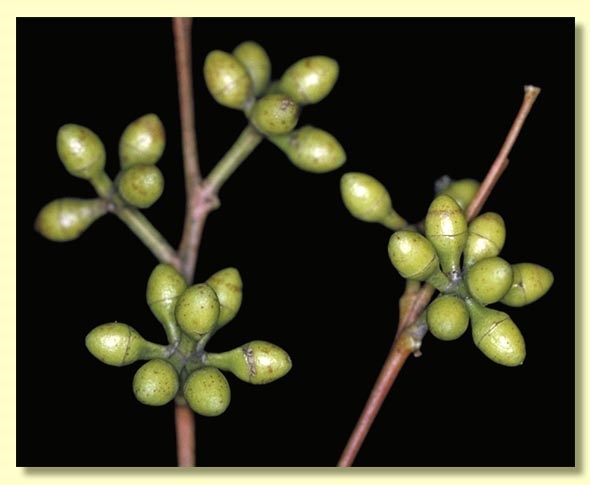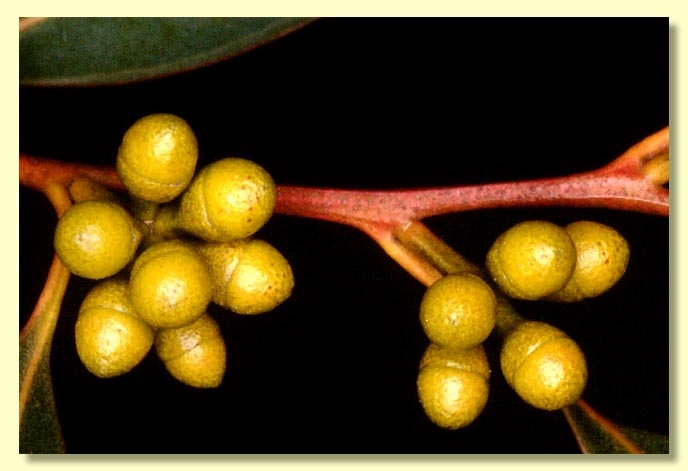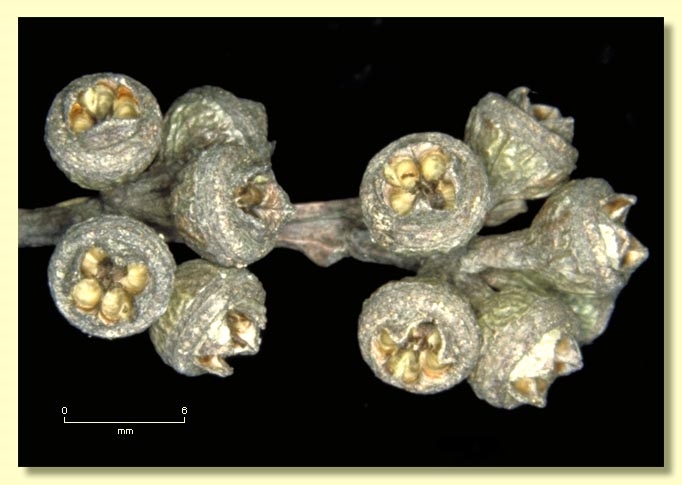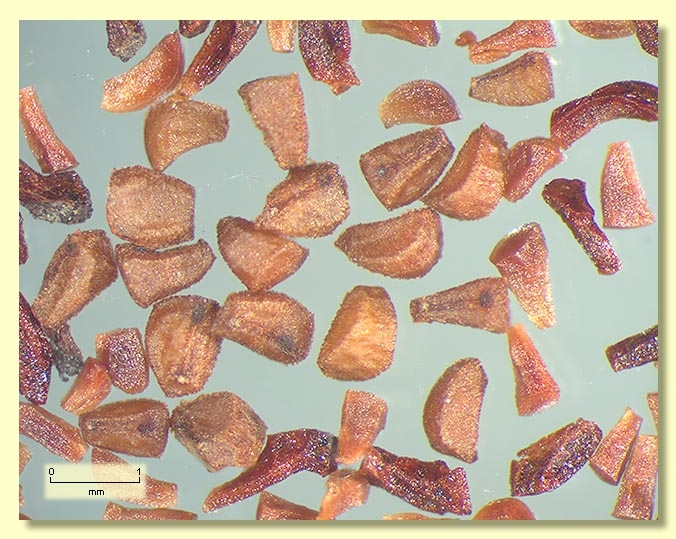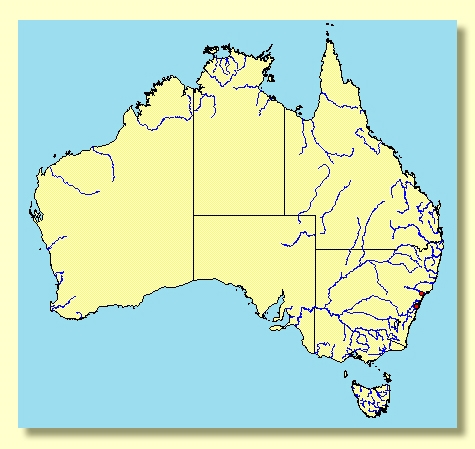Euclid - Online edition
Eucalyptus parramattensis var. sphaerocalyx
Eucalyptus | Symphyomyrtus | Liberivalvae
T: Duck River, NSW, W.Woolls s.n.; holo: NSW.
Bark smooth becoming granular with age, mottled grey, brown, yellow or pink.
Juvenile growth (coppice or field seedlings to 50 cm): stem rounded or square in cross section; juvenile leaves always petiolate, opposite for ca 4 to 7 nodes then alternate, lanceolate, 5–13 cm long, 0.5–4 cm wide, base tapering to petiole, dull, green to blue-green.
Adult leaves alternate, petiole 1–2 cm long; blade lanceolate to falcate, 7–16 cm long, 1.5–3 cm wide, base tapering to petiole, concolorous, glossy, green, side-veins greater than 45° to midrib, moderately reticulate, intramarginal vein parallel to and remote from margin, oil glands mostly island.
Inflorescence axillary unbranched, peduncles 0.3–1 cm long, buds 7, pedicellate (pedicels 0.1–0.3 cm long). Mature buds ovoid to globular (0.4–0.7 cm long, 0.3–0.5 cm wide), yellow or creamy, scar present, operculum usually rounded (0.2–0.4 cm long), stamens erect or irregularly flexed, anthers cuboid to oblong, versatile, dorsifixed, dehiscing by longitudinal slits (non-confluent), style long, stigma blunt, locules usually 4, the placentae each with 6 vertical ovule rows. Flowers white.
Fruit pedicellate (pedicels 0.1–0.4 cm long), hemispherical, 0.3–0.6 cm long, 0.5–0.7 cm wide, disc raised-convex to annular, valves usually 4, exserted.
Seeds brown, 0.8–1 mm long, pyramidal or cuboid, dorsal surface usually pitted, hilum terminal.
Cultivated seedlings (measured at ca node 10): cotyledons oblong; stems square in cross-section; leaves always petiolate, opposite for 3 to 7 nodes, then alternate, lanceolate, 6–13 cm long, 1.2–4 cm wide, base tapering, dull, green.
Flowering time unknown.
Eucalyptus parramattensis is a small to medium-sized red gum tree species endemic to New South Wales, occurring on the coastal plains and ranges from the Sydney suburban area, north and north-west, e.g. Putty Road, to the Hunter Valley and the southern end of the Northern Tablelands. E. parramattensis is characterised by its smooth bark, the small ovoid buds with a short blunt to conic operculum, fruit with disc free on its inner edge from the ovary roof, and strongly exserted valves.
E. parramattensis is one of a closely related to the group of red gums (Eucalyptus section Liberivalvae) that are distinguished by having fruit with an annular disc and brown (not black) toothed, single-coated, cuboid to pyramidal seeds. There are four other species in this group—E. bancroftii, E. prava, E. seeana and E. interstans. E. parramattensis differs from all four by its much smaller buds with a short blunt operculum.
Within its area of occurrence, E. parramattensis may be confused with two other closely related, smooth-barked eucalypts, viz. E. tereticornis and E. amplifolia. E. tereticornis and E. amplifolia can be distinguished by having fruit with a steeply ascending disc that is fused to the ovary roof, unlike the annular disc of E. parramattensis that is free from the ovary roof; this is visible whether fruit is unopened or opened (dehisced). Both can be further separated from E. parramattensis by having larger buds with a longer, more acute operculum.
There are three subspecific taxa:
E. parramattensis subsp. parramattensis
Occurs from north-west of Sydney, and has a conical operculum.
E. parramattensis subsp. decadens
Occurs from the lower Hunter Valley, e.g. Williamtown and Kurri Kurri districts. Subsp. decadens differs from subsp. parramattensis by the larger leaves, buds and fruits and is typically a tumble-down poorly formed tree.
E. parramattensis var. sphaerocalyx
Occurs from near Parramatta (a suburb of Sydney) to the foothills of the Blue Mountains. Subsp. sphaerocalyx has a rounded operculum.
Eucalyptus parramattensis subsp. decadens is listed as "Vulnerable" under the Australian Government Environment Protection and Biodiversity Conservation Act 1999 (EPBC Act). Further information may be found at this web address:
http://www.environment.gov.au/cgi-bin/sprat/public/sprat.pl
MORE ABOUT RED GUMS AND OTHER ASSOCIATED GROUPS
var. sphaerocalyx: Greek sphaera, a ball, and calyx calyx, referring to the shape of the operculum.


